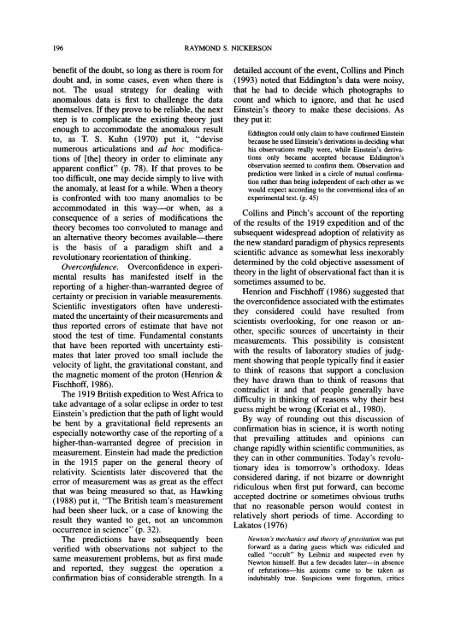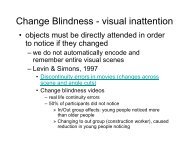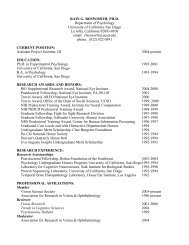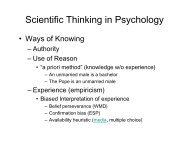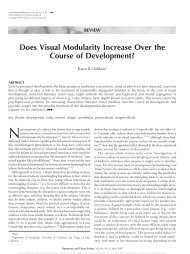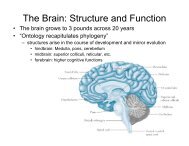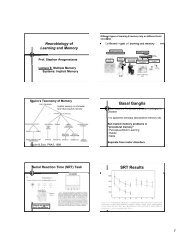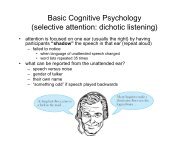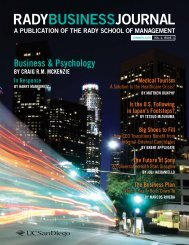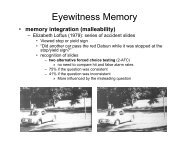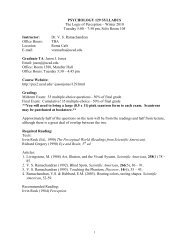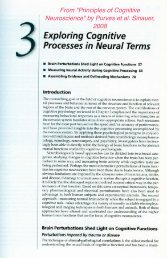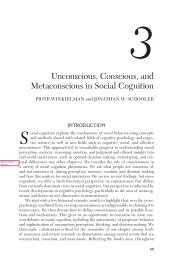Confirmation Bias: A Ubiquitous Phenomenon in Many Guises
Confirmation Bias: A Ubiquitous Phenomenon in Many Guises
Confirmation Bias: A Ubiquitous Phenomenon in Many Guises
Create successful ePaper yourself
Turn your PDF publications into a flip-book with our unique Google optimized e-Paper software.
196 RAYMOND S. NICKERSON<br />
benefit of the doubt, so long as there is room for<br />
doubt and, <strong>in</strong> some cases, even when there is<br />
not. The usual strategy for deal<strong>in</strong>g with<br />
anomalous data is first to challenge the data<br />
themselves. If they prove to be reliable, the next<br />
step is to complicate the exist<strong>in</strong>g theory just<br />
enough to accommodate the anomalous result<br />
to, as T. S. Kuhn (1970) put it, "devise<br />
numerous articulations and ad hoc modifications<br />
of [the] theory <strong>in</strong> order to elim<strong>in</strong>ate any<br />
apparent conflict" (p. 78). If that proves to be<br />
too difficult, one may decide simply to live with<br />
the anomaly, at least for a while. When a theory<br />
is confronted with too many anomalies to be<br />
accommodated <strong>in</strong> this way—or when, as a<br />
consequence of a series of modifications the<br />
theory becomes too convoluted to manage and<br />
an alternative theory becomes available—there<br />
is the basis of a paradigm shift and a<br />
revolutionary reorientation of th<strong>in</strong>k<strong>in</strong>g.<br />
Overconfidence. Overconfidence <strong>in</strong> experimental<br />
results has manifested itself <strong>in</strong> the<br />
report<strong>in</strong>g of a higher-than-warranted degree of<br />
certa<strong>in</strong>ty or precision <strong>in</strong> variable measurements.<br />
Scientific <strong>in</strong>vestigators often have underestimated<br />
the uncerta<strong>in</strong>ty of their measurements and<br />
thus reported errors of estimate that have not<br />
stood the test of time. Fundamental constants<br />
that have been reported with uncerta<strong>in</strong>ty estimates<br />
that later proved too small <strong>in</strong>clude the<br />
velocity of light, the gravitational constant, and<br />
the magnetic moment of the proton (Henrion &<br />
Fischhoff, 1986).<br />
The 1919 British expedition to West Africa to<br />
take advantage of a solar eclipse <strong>in</strong> order to test<br />
E<strong>in</strong>ste<strong>in</strong>'s prediction that the path of light would<br />
be bent by a gravitational field represents an<br />
especially noteworthy case of the report<strong>in</strong>g of a<br />
higher-than-warranted degree of precision <strong>in</strong><br />
measurement. E<strong>in</strong>ste<strong>in</strong> had made the prediction<br />
<strong>in</strong> the 1915 paper on the general theory of<br />
relativity. Scientists later discovered that the<br />
error of measurement was as great as the effect<br />
that was be<strong>in</strong>g measured so that, as Hawk<strong>in</strong>g<br />
(1988) put it, "The British team's measurement<br />
had been sheer luck, or a case of know<strong>in</strong>g the<br />
result they wanted to get, not an uncommon<br />
occurrence <strong>in</strong> science" (p. 32).<br />
The predictions have subsequently been<br />
verified with observations not subject to the<br />
same measurement problems, but as first made<br />
and reported, they suggest the operation a<br />
confirmation bias of considerable strength. In a<br />
detailed account of the event, Coll<strong>in</strong>s and P<strong>in</strong>ch<br />
(1993) noted that Edd<strong>in</strong>gton's data were noisy,<br />
that he had to decide which photographs to<br />
count and which to ignore, and that he used<br />
E<strong>in</strong>ste<strong>in</strong>'s theory to make these decisions. As<br />
they put it:<br />
Edd<strong>in</strong>gton could only claim to have confirmed E<strong>in</strong>ste<strong>in</strong><br />
because he used E<strong>in</strong>ste<strong>in</strong>'s derivations <strong>in</strong> decid<strong>in</strong>g what<br />
his observations really were, while E<strong>in</strong>ste<strong>in</strong>'s derivations<br />
only became accepted because Edd<strong>in</strong>gton's<br />
observation seemed to confirm them. Observation and<br />
prediction were l<strong>in</strong>ked <strong>in</strong> a circle of mutual confirmation<br />
rather than be<strong>in</strong>g <strong>in</strong>dependent of each other as we<br />
would expect accord<strong>in</strong>g to the conventional idea of an<br />
experimental test. (p. 45)<br />
Coll<strong>in</strong>s and P<strong>in</strong>ch's account of the report<strong>in</strong>g<br />
of the results of the 1919 expedition and of the<br />
subsequent widespread adoption of relativity as<br />
the new standard paradigm of physics represents<br />
scientific advance as somewhat less <strong>in</strong>exorably<br />
determ<strong>in</strong>ed by the cold objective assessment of<br />
theory <strong>in</strong> the light of observational fact than it is<br />
sometimes assumed to be.<br />
Henrion and Fischhoff (1986) suggested that<br />
the overconfidence associated with the estimates<br />
they considered could have resulted from<br />
scientists overlook<strong>in</strong>g, for one reason or another,<br />
specific sources of uncerta<strong>in</strong>ty <strong>in</strong> their<br />
measurements. This possibility is consistent<br />
with the results of laboratory studies of judgment<br />
show<strong>in</strong>g that people typically f<strong>in</strong>d it easier<br />
to th<strong>in</strong>k of reasons that support a conclusion<br />
they have drawn than to th<strong>in</strong>k of reasons that<br />
contradict it and that people generally have<br />
difficulty <strong>in</strong> th<strong>in</strong>k<strong>in</strong>g of reasons why their best<br />
guess might be wrong (Koriat et al., 1980).<br />
By way of round<strong>in</strong>g out this discussion of<br />
confirmation bias <strong>in</strong> science, it is worth not<strong>in</strong>g<br />
that prevail<strong>in</strong>g attitudes and op<strong>in</strong>ions can<br />
change rapidly with<strong>in</strong> scientific communities, as<br />
they can <strong>in</strong> other communities. Today's revolutionary<br />
idea is tomorrow's orthodoxy. Ideas<br />
considered dar<strong>in</strong>g, if not bizarre or downright<br />
ridiculous when first put forward, can become<br />
accepted doctr<strong>in</strong>e or sometimes obvious truths<br />
that no reasonable person would contest <strong>in</strong><br />
relatively short periods of time. Accord<strong>in</strong>g to<br />
Lakatos (1976)<br />
Newton's mechanics and theory of gravitation was put<br />
forward as a dar<strong>in</strong>g guess which was ridiculed and<br />
called "occult" by Leibniz and suspected even by<br />
Newton himself. But a few decades later—<strong>in</strong> absence<br />
of refutations—his axioms came to be taken as<br />
<strong>in</strong>dubitably true. Suspicions were forgotten, critics


